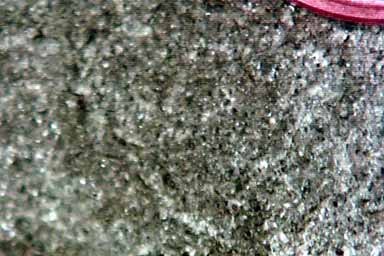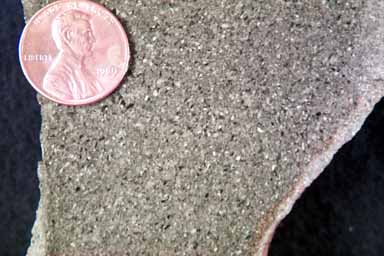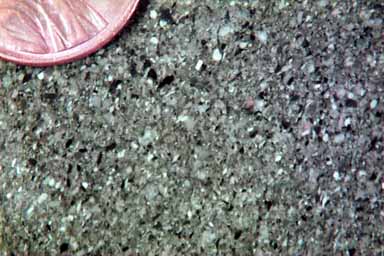igneous rocks
metamorphic
rocks
sedimentary rocks
|
QFL Composition
Description
Fine grained sandstone with 25-50% matrix (making it a wacke). In this specimen the grains are small enough and the matrix abundant enough it can be difficult at first to notice the sandstone nature of the rock. We can only know by getting closer, a lot closer, to the rock.
The gray color, darker in the actual rock than in this picture, also masks the composition. We have to saw cut the rock, and wet the surface to see the qfl.
Tectonic Association
Lithic wacke sandstones, especially those containing feldspar are associated with regions of great tectonic activity. This specimen was eroded from a volcanic arc system that collided with eastern North America during the Taconic Orogeny. It was deposited as a turbidity current in a submarine fan. A typical tectonic occurrence for a rock of this composition.
Sandstones like this come from incomplete weathering, rapid transportation, and rapid burial relatively close to the sourceland. This rock (from the Ordovician Martinsburg formation) comes from a Bouma sequence (deposit of a turbidity current, an underwater avalanche) deposited in a submarine fan.
Detail

QFL Composition
Description
In this closeup, partially out of focus, we can see the sandstone nature of the rock. We can also see the black specks in the rock which are the lithic fragments. Feldspar is also present but harder to distinguish from the quartz.
It is harder to see the wacke nature (matrix in which the sand grains are imbedded) without getting the specimen under a microscope and rotating it around. What we would observe is that the sand grains appear imbedded in a matrix, like islands standing up out of the sea. This is in contrast to a Rock With Little Or No Matrix where it is possible to see the grains contact each other along their sides.
Saw Cut

QFL Composition
Description
The lithics and feldspars stand out more clearly in this closeup. We can also begin to discern the quartzgrains, although the matrix is still transparent because it is wet.
Closer Sawcut

QFL Composition
Description
Along this cut surface, wet with water, the sand grains stand out clearly. The black specks are lithic fragments; many of the white specks are feldspars (although some may be quartz or lithics). The grayer areas inbetween are quartz grains and matrix. Matrix becomes transparent when the rock is wet, so it is impossible to see here.
|